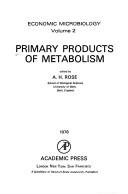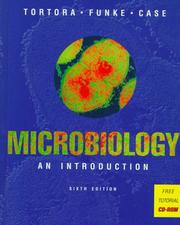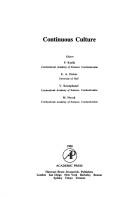| Listing 1 - 10 of 51 | << page >> |
Sort by
|

ISBN: 0125965524 0323148395 1299461360 Year: 1978 Publisher: London Academic Press
Abstract | Keywords | Export | Availability | Bookmark
 Loading...
Loading...Choose an application
- Reference Manager
- EndNote
- RefWorks (Direct export to RefWorks)
Industrial microbiology. --- Microbial metabolites. --- Biochemie --- Micro-organismen --- Biochemie. --- Micro-organismen.

ISBN: 0805385355 Year: 1998 Publisher: Memlo Park : Benjamin/Cummings,
Abstract | Keywords | Export | Availability | Bookmark
 Loading...
Loading...Choose an application
- Reference Manager
- EndNote
- RefWorks (Direct export to RefWorks)
microbiologie --- micro-organismen --- General microbiology --- Microbiology.
Book
ISBN: 9780321584205 0321584201 Year: 2010 Publisher: San Francisco Benjamin/Cummings
Abstract | Keywords | Export | Availability | Bookmark
 Loading...
Loading...Choose an application
- Reference Manager
- EndNote
- RefWorks (Direct export to RefWorks)
General microbiology --- micro-organismen --- microbiologie --- Microbiologie --- 579

ISBN: 0124311709 9780124311701 Year: 1988 Publisher: London Academic Press
Abstract | Keywords | Export | Availability | Bookmark
 Loading...
Loading...Choose an application
- Reference Manager
- EndNote
- RefWorks (Direct export to RefWorks)
General microbiology --- micro-organismen --- Continuous culture (Microbiology)
Book
ISBN: 9780839149149 Year: 2007 Publisher: Boca Raton CRC Press
Abstract | Keywords | Export | Availability | Bookmark
 Loading...
Loading...Choose an application
- Reference Manager
- EndNote
- RefWorks (Direct export to RefWorks)
Predicting the growth and behaviour of microorganisms in food has long been an aim in food microbiology research. In recent years, microbial models have evolved to become more exact and the discipline of quantitative microbial ecology has gained increasing importance for food safety management, particularly as minimal processing techniques have become more widely used. These processing methods operate closer to microbial death, survival and growth boundaries and therefore require even more precise models. Written by a team of leading experts in the field, Modelling microorganims in food assesses the latest developments and provides an outlook for the future of microbial modelling. Part one discusses general issues involved in building models of microbial growth and inactivation in foods, with chapters on the historical background of the field, experimental design, data processing and model fitting, the problem of uncertainty and variability in models and modelling lag-time. Further chapters review the use of quantitative microbiology tools in predictive microbiology and the use of predictive microbiology in risk assessment. The second part of the book focuses on new approaches in specific areas of microbial modelling, with chapters discussing the implications of microbial variability in predictive modelling and the importance of taking into account microbial interactions in foods. Predicting microbial inactivation under high pressure and the use of mechanistic models are also covered. The final chapters outline the possibility of incorporating systems biology approaches into food microbiology.
Nutritionary hygiene. Diet --- voedselmicrobiologie --- probiotics --- micro-organismen

ISBN: 3527257705 0895730480 9783527257706 Year: 1986 Publisher: Weinheim Deerfield Beach Basel VCH
Abstract | Keywords | Export | Availability | Bookmark
 Loading...
Loading...Choose an application
- Reference Manager
- EndNote
- RefWorks (Direct export to RefWorks)
Biochemical engineering --- biotechnologie --- micro-organismen --- drinkwater --- zeewater --- afvalwater --- biomassa
Book
ISBN: 9780131968936 Year: 2006 Publisher: New Jersey : Pearson Education,
Abstract | Keywords | Export | Availability | Bookmark
 Loading...
Loading...Choose an application
- Reference Manager
- EndNote
- RefWorks (Direct export to RefWorks)
microbiologie --- micro-organismen --- bacteriën --- opleiding biotechnologie --- PXL-Tech 2016
Book
ISBN: 9781441959782 9781441959799 9781441959805 9781461425779 Year: 2010 Publisher: New York NY Springer New York
Abstract | Keywords | Export | Availability | Bookmark
 Loading...
Loading...Choose an application
- Reference Manager
- EndNote
- RefWorks (Direct export to RefWorks)
The microbial world has given us many surprises including microbes that grow under extremely harsh conditions (122C at 40 MPa), novel metabolisms such as the uranium and perchlorate reduction, and novel chemicals that can be used to control diseases. We continually face new and difficult problems such as the need to transition to more carbon-neutral energy sources and to find eco-friendly chemicals and to find new drugs to treat disease. Will it be possible to tap into the seemingly limitless potential of microbial activity to solve our current and future problems?The answer to this question is probably yes. We are already looking to the microbial world to provide new energy sources, green chemicals to replace those made from petroleum, and new drugs to fight disease. To help us along these paths, we are deciphering how microorganisms interact with each other. We know that microbial populations interact and communicate with each other. The language that microbes use is chemical where small molecules are exchanged among different microbial cells. Sometimes, these chemicals suppress activities of competitors and could be used as antibiotics or may have other therapeutic uses. Other times, the chemicals stimulate complex responses in microbial populations such as fruiting body or biofilm formation. By understanding the conversation that microbes are having among themselves, e. g.
Surface chemistry --- Biotechnology --- U (uranium) --- biofilm --- micro-organismen --- biotechnologie
Book
ISBN: 9788792763228 Year: 2012 Publisher: Kgs. Lyngby : DTU Food, National Food Institute,
Abstract | Keywords | Export | Availability | Bookmark
 Loading...
Loading...Choose an application
- Reference Manager
- EndNote
- RefWorks (Direct export to RefWorks)
This thesis provides an evaluation of the Danish Campylobacter situation from 2001 to 2010. The evaluation includes a description of the Danish situation in relation to the national control strategy and control measures applied at slaughter, an assessment of human risk of campylobacteriosis from retail broiler meat in the period 2001-2010 for assessment of the effect of implemented control measures, and finally, exploration of the apportioning of human campylobacteriosis cases caused by Campylobacter jejuni in Denmark to different sources of animal origin. Danish action plans to control Campylobacter in broilers and broiler meat comprise initiatives covering the whole domestic food chain “from farm to fork”. Initiatives involve biosecurity in the primary production; scheduling of Campylobacter negative flocks to production of chilled meat and positive flocks to the production of frozen products, to the extent possible, and consumer campaigns to reduce cross-contamination in domestic kitchens (manuscript I). In addition, a case-by-case control was introduced in 2007; targeting high-risk batches of fresh meat of Danish and imported origin. With the implementation of the first Danish initiatives and action plans against Campylobacter, the prevalence decreased in the Danish broilers from 2002 to 2004 as well as in chilled broiler meat at slaughter, 2004-2006 (manuscript I). The registered number of human cases was lower in the period after the implementation of action plans (2003-2010) compared to the period before (2001-2002). The Campylobacter prevalence in Danish broiler flocks was found to be a strong predictor for the seasonal occurrence of Campylobacter in Danish chilled broiler meat. Seasonality was more distinct for chilled meat compared to frozen meat, and was more pronounced for Danish meat compared to imported meat (manuscript II). The measures implemented in the major Danish slaughterhouses (forced air chilling, crust freezing and freezing) with
Bacteriologie. --- Basic Sciences. Microbiology -- Bacteriology --- Micro-organismen. --- Virologie.
Digital
ISBN: 9781441959782 9781441959799 9781441959805 9781461425779 Year: 2010 Publisher: New York, N.Y. Springer Science+Business Media
Abstract | Keywords | Export | Availability | Bookmark
 Loading...
Loading...Choose an application
- Reference Manager
- EndNote
- RefWorks (Direct export to RefWorks)
- Presents an overview of production and use of biosurfactants - Covers alternative substrates and fermentation approaches to reduce cost and optimize biosurfactant production - Reviews applications in environmental clean-up, oil recovery, and medicine The microbial world has given us many surprises including microbes that grow under extremely harsh conditions (122C at 40 MPa), novel metabolisms such as the uranium and perchlorate reduction, and novel chemicals that can be used to control diseases. We continually face new and difficult problems such as the need to transition to more carbon-neutral energy sources and to find eco-friendly chemicals and to find new drugs to treat disease. Will it be possible to tap into the seemingly limitless potential of microbial activity to solve our current and future problems?The answer to this question is probably yes. We are already looking to the microbial world to provide new energy sources, green chemicals to replace those made from petroleum, and new drugs to fight disease. To help us along these paths, we are deciphering how microorganisms interact with each other. We know that microbial populations interact and communicate with each other. The language that microbes use is chemical where small molecules are exchanged among different microbial cells. Sometimes, these chemicals suppress activities of competitors and could be used as antibiotics or may have other therapeutic uses. Other times, the chemicals stimulate complex responses in microbial populations such as fruiting body or biofilm formation. By understanding the conversation that microbes are having among themselves, e. g. The microbial world has given us many surprises including microbes that grow under extremely harsh conditions (122C at 40 MPa), novel metabolisms such as the uranium and perchlorate reduction, and novel chemicals that can be used to control diseases. We continually face new and difficult problems such as the need to transition to more carbon-neutral energy sources and to find eco-friendly chemicals and to find new drugs to treat disease. Will it be possible to tap into the seemingly limitless potential of microbial activity to solve our current and future problems?The answer to this question is probably yes. We are already looking to the microbial world to provide new energy sources, green chemicals to replace those made from petroleum, and new drugs to fight disease. To help us along these paths, we are deciphering how microorganisms interact with each other. We know that microbial populations interact and communicate with each other. The language that microbes use is chemical where small molecules are exchanged among different microbial cells. Sometimes, these chemicals suppress activities of competitors and could be used as antibiotics or may have other therapeutic uses. Other times, the chemicals stimulate complex responses in microbial populations such as fruiting body or biofilm formation. By understanding the conversation that microbes are having among themselves, e. g.
Surface chemistry --- Biotechnology --- U (uranium) --- biofilm --- micro-organismen --- biotechnologie
| Listing 1 - 10 of 51 | << page >> |
Sort by
|

 Search
Search Feedback
Feedback About
About Help
Help News
News